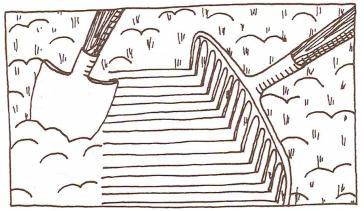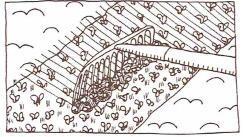Weeds are green and while some, like lamb's quarters and purslane, can be eaten as greens, you really don't want them growing in among your salad crops. They steal moisture, fertilizer and sunlight. Some of the slower-growing greens can be shaded out of your garden forever by weeds.
Weed Prevention
There are ways to avoid weed problems in any garden - even if you've suffered from weeding fits in the past:
* Try to plant your fine-seeded greens in a section of garden that was relatively weed-free the season before. For example, where your thick, weed-smothering wide rows of beans grew.
* Work the soil with a shovel, rake or tiller a couple of times the week or so before planting. This uproots the tiniest weed seedlings and kills them or buries them (which kills them, too).

To Win - Thin!
Whether you plant in wide, single, double or multiple rows, you'll need to thin your greens to have a really successful crop. Because the seeds of most greens are so tiny, we inevitably plant a little too thickly. That's not bad, though - it helps guarantee a good stand of plants.
You just have to thin out the crowd, so your plants will have enough room to grow without too much competition from their neighbors. Thinning also provides good air circulation around plants to keep them from staying wet and becoming diseased. You can spend hours thinning by hand, or you can spend one minute using an iron rake. To thin a row, simply pull the rake across it - with the teeth digging into the soil only about 1/4 inch. The teeth remove just enough seedlings, leaving the remaining ones properly spaced. They'll look a little beat up, but don't panic. The plants will snap back quickly and get growing again, better than ever. Rake thinning also gets rid of many small weeds that may have started to germinate, again saving you tedious hand-weeding time.
To thin by hand, simply bend over and gently pull up enough plants so the remaining ones are spaced correctly. For example, in the case of leaf lettuce, the plants should stand three to four inches apart; butterhead lettuce, four to eight inches (six to 10 inches if you want a bigger head). Leave six to 10 inches between plants if you're thinning collards, kale or mustard.
The First Thinning
Make your first thinning timely. When your vegetable seedlings are 1/4 to 1/2 inch tall, drag an iron rake across the row, as described above. This thins the plants, of course, but it's also your first weeding effort. Hand weed as often as necessary until the wide-row greens develop enough foliage to shade out further weed growth. Remember, the more weeding you do early on, the less you'll have to do later.
If you set out lettuce, collards or other transplants, work the soil before planting them, and wait a week or so for them to take hold before you cultivate near them. In the first few weeks after being transplanted, the plant's roots are quite close to the surface and gaining strength by the day. Don't be careless with a hoe and risk slowing them down or killing them. Keep all cultivation very shallow, 1/2 to one inch deep at most.

Mulching
Use a good mulch "or soil covering" to stop weeds around head lettuce plants, collards or plants in a single row. Hay, straw or other organic matter will stop most weeds except some stubborn perennials, which will grow through it. Pull those by hand.
Pull weeds when they're small. Don't even wait till they come up out of the ground. After a rain, which will cause some weed seeds to germinate, allow the soil to dry slightly and then lightly stir it up with your rake or weeding tool. You'll kill many weeds before they even appear.
 Victory Seed Company has all the seeds you want for your best garden in 2024.
Victory Seed Company has all the seeds you want for your best garden in 2024.
For 25 years, the family-owned Victory Seed Company has provided the highest quality vegetable, herb and flower seeds to families across the country. We are passionate about providing you the best seeds available that give excellent germination, robust plants, and the harvest you want. With a catalog of over a thousand varieties, we have everything, and our prices are the kinds that we'd want to pay. We have hundreds of yesterday's heirloom vegetables, as well as today's award winning hybrid selections. Get to know us by visiting our website and browsing through our online vegetable seed catalog.
| 1. Cultivating Greens ← you're on this article right now |
| 2. Fertilizing Greens |
| 3. Watering Greens Crops |
| 4. Solving Lettuce Problems |
| 5. Greens' Diseases & Insects |
| 6. Cabbage Pests |
| 1. Cultivating Greens ← you're on this article right now |
| 2. Fertilizing Greens |
| 3. Watering Greens Crops |
| 4. Solving Lettuce Problems |
| 5. Greens' Diseases & Insects |
| 6. Cabbage Pests |